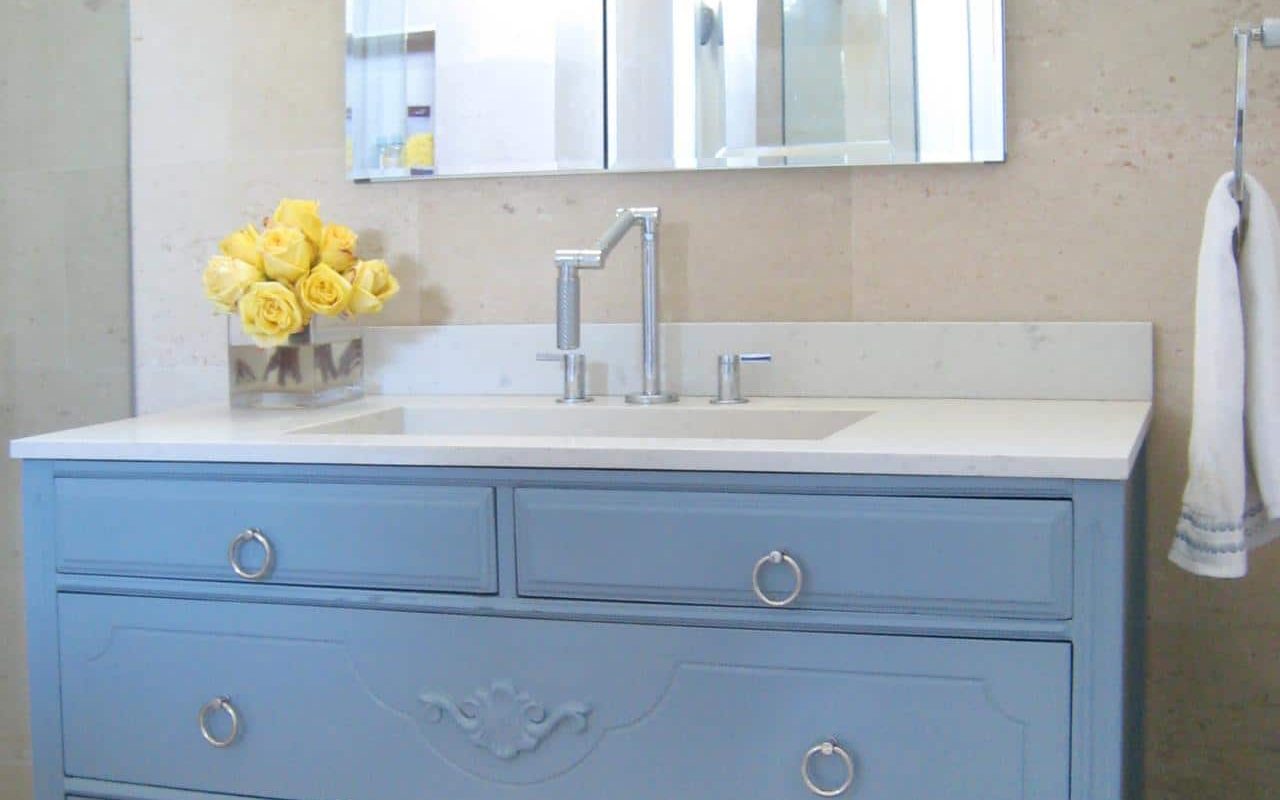The question of how to turn a cabinet into a bathroom vanity arises mainly because of budget constraints. You may not have a budget to buy a new bathroom vanity but you have enough to purchase a cabinet from a thrift store that you can repurpose for another use. Turn that old cabinet into a dresser vanity in no time with these practical and simple steps.

Preparation Work
1. Set your budget
Before you start your work on how to turn a cabinet into a bathroom vanity, the first thing that you need to do is evaluate your budget. How much money are you going to use to turn a cabinet into a homemade vanity unit? Set the maximum amount that you are willing to spend on this project.
2. Clean your bathroom
Before you start doing measurements, you should clean the area where you will place the cabinet. It will be easier to move around and set the vanity up if the section is neat and clean. It will make your job easier.
3. Measure your bathroom
You can do this without any added cost. Get a measuring device to measure the portion of the bathroom where the dresser vanity will be put. Add some space for specific distances between plumbing fittings and bathroom walls.
4. Pick the dresser or cabinet
Go to thrift shops, flea markets, and yard sales to look for the perfect dresser that you can use. The dresser does not have to be modern or contemporary. You can upgrade your current bathroom aesthetic by using antique furniture for your bathroom vanity.
Be sure to look at the exterior and interior of the dresser. Examine the exterior if minimal repairs are needed. Do the same visual inspection of the interior of the cabinet. If it passes your standards, then you can purchase this cabinet and bring it to your home for repurposing.

Tools and Materials You Need
List the items that you are going to use for the project.
Main Items
- Cabinet or dresser
- Drop-in sink
- Faucet
Tools
- Electric drill
- Circular saw
- jigsaw
- Measuring tape
- Wood clamps
- Hammer
Consumables
- Nails
- Wood glue
- Pencil
- Silicone caulk
- Cloth
Step-by-Step Tutorial
Now that you have everything prepared, you can now start working on modifying the cabinet and installing it in your bathroom.
1. Go to a place with enough space to work
Pick a place near the bathroom so that you can easily do some re-measuring when needed. The area should allow you to work comfortably. It should also have some breathing room since you are going to use chemicals and sawdust will be present because of cutting wood.
2. Mark a line for the sink placement
Mark the top of the cabinet with chalk for the space allotted for the drop-in sink. Since the sink will be placed on top of the cabinet, the mark should be at least one inch inside the trace line.
3. Cut the hole using a jigsaw
Use an electric drill to create holes along the trace line. Use a jigsaw to cut from one hole to the next. Make sure to use a drill bit that is small. Double-check your measurements before you start cutting on the wood.
4. Remove the drawers
You do not need to totally remove all the drawers of the cabinet after the work is done. You just have to make some space for the in-plumbing to be installed. For some cabinets, two or more shelving should be cut. For dressers, you do not only have to remove drawers but also the tongue and grooves.
5. Reassemble the drawers
Put the drawers back for a proper fit. Make some adjustments when needed. Use wood glue on drawer fronts that should be installed back in the cabinet. You may also want to use hammer and finishing nails.
6. Cut the back and bottom of the cabinet
Because of the plumbing to be installed under the sink, you will need to cut the back and bottom portion of the dresser. Do some measurements and cut using a circular saw or jigsaw. If the cabinet becomes wobbly because of the removal of some parts, you may need to reinforce its wooden support.
7. For added protection, seal the wood
To extend the life of the cabinet, you need to seal it with wood epoxy or marine varnish. These chemicals will protect the cabinet from moisture that is present inside the bathroom.
8. Install the sink and plumbing
Place the sink on top of the hole cut on the cabinet. Install the plumbing at the bottom of the sink. Use sealants when necessary. The water line should be connected to the faucet on top of the sink. The drain should be connected to the drain line.
Conclusion
Now that the question of how to turn a cabinet into a bathroom vanity is answered, the next thing is to plan ahead. Prepare all the materials and tools that you need. Decide on the cabinet that you will convert into a bathroom vanity. Make some measurements to ensure that all dimensions are accounted for. And most of all, enjoy the whole process. You are saving money on the bathroom vanity and you are also upgrading the look of your bathroom.
Frequently Asked Questions about How to Turn a Cabinet into a Bathroom Vanity
Yes, you can. You can get old dressers or cabinets from thrift shops and turn them into bathroom vanities. Yard sales also offer cabinets that can be converted into vanities.
An ordinary cabinet can be used as storage in the bathroom. But if you are going to utilize the cabinet as a homemade vanity unit, you should consider the existing plumbing under the sink that needs provision. You should also do some repairs and preventive maintenance work on the cabinet so that it will not be a breeding place for molds and mildew.
0 Comments for “How to Turn a Cabinet into a Bathroom Vanity | Save on Money”